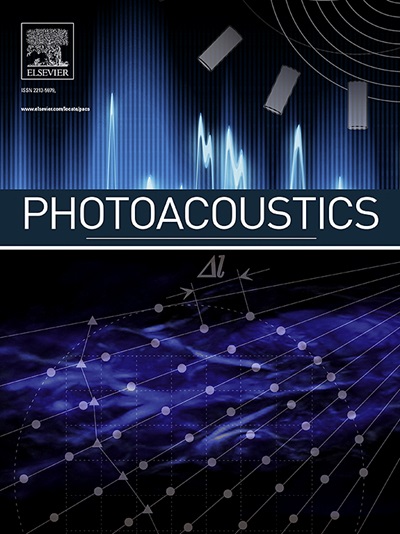Photoacoustic spectroscopy detection based on complementary interdigital cantilever enhanced Fabry-Perot acoustic sensor
IF 6.8
1区 医学
Q1 ENGINEERING, BIOMEDICAL
引用次数: 0
Abstract
Photoacoustic spectroscopy (PAS) has been widely used for detecting trace gases, but enhancing sound pressure detection capability of the acoustic sensor is crucial for improving gas detection sensitivity of the PAS system. In this paper, a complementary interdigital (CID) cantilever Fabry-Perot (F-P) fiber optic acoustic sensor (FOAS) was developed. Experimental results demonstrated that the CID cantilever operated at its resonance frequency of 1010 Hz exhibited a high sensitivity of 923.7 nm/Pa, and exhibited a signal-to-noise ratio of 72.2 dB and a minimum detectable pressure of 16.4 μPa/Hz 1/2 at 1 kHz. In the concentration range of 20 ppm to 100 ppm, the sensitivity of PAS to C₂H₂ gas was 3.02 pm/ppm and the detection limits of C₂H₂ in N₂ background was 30.17 ppb. This design employs highly sensitive cantilevers with tunable resonance, enhancing the gas detection sensitivity of the PAS system by leveraging resonant frequency matching and signal amplification.
基于互补数字间悬臂增强法布里-珀罗声传感器的光声光谱检测
光声光谱技术已广泛应用于痕量气体的检测,但提高声传感器的声压检测能力是提高光声光谱系统气体检测灵敏度的关键。本文研制了一种互补数字式悬臂式法布里-珀罗(F-P)光纤声传感器。实验结果表明,CID悬臂梁在1010 Hz谐振频率下工作,灵敏度为923.7 nm/Pa,信噪比为72.2 dB,在1 kHz下的最小检测压力为16.4 μPa/Hz 1/2。在20 ppm ~ 100 ppm的浓度范围内,PAS对二氧化碳的灵敏度为3.02 pm/ppm,在n2背景下二氧化碳的检出限为30.17 ppb。本设计采用谐振可调的高灵敏度悬臂梁,利用谐振频率匹配和信号放大,提高了PAS系统的气体检测灵敏度。
本文章由计算机程序翻译,如有差异,请以英文原文为准。
求助全文
约1分钟内获得全文
求助全文
来源期刊

Photoacoustics
Physics and Astronomy-Atomic and Molecular Physics, and Optics
CiteScore
11.40
自引率
16.50%
发文量
96
审稿时长
53 days
期刊介绍:
The open access Photoacoustics journal (PACS) aims to publish original research and review contributions in the field of photoacoustics-optoacoustics-thermoacoustics. This field utilizes acoustical and ultrasonic phenomena excited by electromagnetic radiation for the detection, visualization, and characterization of various materials and biological tissues, including living organisms.
Recent advancements in laser technologies, ultrasound detection approaches, inverse theory, and fast reconstruction algorithms have greatly supported the rapid progress in this field. The unique contrast provided by molecular absorption in photoacoustic-optoacoustic-thermoacoustic methods has allowed for addressing unmet biological and medical needs such as pre-clinical research, clinical imaging of vasculature, tissue and disease physiology, drug efficacy, surgery guidance, and therapy monitoring.
Applications of this field encompass a wide range of medical imaging and sensing applications, including cancer, vascular diseases, brain neurophysiology, ophthalmology, and diabetes. Moreover, photoacoustics-optoacoustics-thermoacoustics is a multidisciplinary field, with contributions from chemistry and nanotechnology, where novel materials such as biodegradable nanoparticles, organic dyes, targeted agents, theranostic probes, and genetically expressed markers are being actively developed.
These advanced materials have significantly improved the signal-to-noise ratio and tissue contrast in photoacoustic methods.
 求助内容:
求助内容: 应助结果提醒方式:
应助结果提醒方式:


